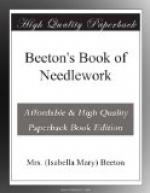[Illustration: 517.—Star.]
[Illustration: 518.—Star.]
No. 520 consists of a double cross formed by twisted loops of linen thread. Copy these loops exactly from illustration 520 One part of the straight cross lies underneath, then comes the slanting cross, and lastly, the other part of the straight cross.
[Illustration: 519.—Detail of Star.]
[Illustration: 520.—Star.]
In the centre the loops of linen thread are fastened with two rounds of stitches. (See illustration 520).
OVERCAST STITCH is worked like embroidery overcast, and forms the stems of the flowers and leaves of guipure d’art; it is worked over one or two coarse threads. It is employed in No. 530, and forms the triangles in the centre of the middle squares.
* * * * *
[Illustration: 521.—Insertion in Guipure d’Art.]
521.—Insertion in Guipure d’Art.
Materials: Guipure frame netting of 6 holes wide; Mecklenburg thread No. 8 or 10; needle No. 7.
For the netted foundation, which is six holes wide, begin at one corner with 2 stitches, work 5 rows, at the end of each of which increase 1 stitch, continue to work the strip with the same number of stitches, alternately decreasing 1 at the end of one row and increasing 1 at the end of the next. For decreasing net 2 stitches together, for increasing net 2 stitches in the same hole. When the strip is sufficiently long, complete it by decreasing in the same proportion as the increasing at the beginning. As the pattern is so clearly shown in the illustration, it will be very easy to work from it. It is worked in point de feston and star wheels; the border is in point d’esprit. The insertion is finished on either side with a row of button-hole stitches.
* * * * *
522.—Lace Border in Guipure D’Art.
Material: Messrs. Walter Evans and Co.’s Mecklenburg thread No. 8 or 10.
This border may be used for various purposes; it makes a pretty edging for toilet cushions if worked in fine thread, and looks equally well for trimming couvrettes, &c., in No. 2 thread. The netting is nine holes wide, the stitches employed are point d’esprit and point de feston, the edge is in button-hole stitch, the netted ground is cut away outside the scallops.
[Illustration: 522.—Lace Border in Guipure d’Art.]
* * * * *
523.—Square for D’Oyley
Materials: Frame; 1 square of netting; Mecklenburg reel thread Nos. 8 and 10; needle No. 6.
[Illustration: 523.—Pattern of Square for D’Oyley.]
This square may be used to form part of a couvrette, or a d’oyley, or pincushion. The three other corners of the square are worked exactly like the one seen in illustration; the rosette in the centre is shown in full size. The square is worked in point d’esprit, linen stitch, and point de reprise. Each of the leaves of the foliage is worked in one hole of the netting; they are worked by throwing the cotton three times across the hole, and working darning stitch on them. The stem is worked in overcast on the thread of the netting. The daisy in the centre is worked like the leaves, each leaf taking up one or more holes of the netting.




